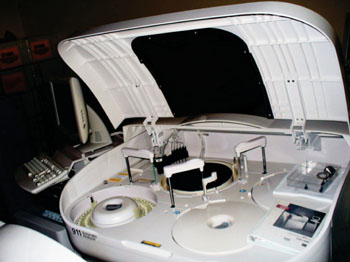High Urate Levels May Indicate Parkinson's Risk in Men
By LabMedica International staff writers
Posted on 26 Jan 2016
Parkinson's disease is a motor system disorder that usually appears in people aged over 60 years and it results from the loss of dopamine-producing brain cells. There is currently no cure, but treatments can be given that replace or mimic the role of dopamine in the brain, providing relief from the symptoms. Posted on 26 Jan 2016
The main symptoms are tremor or trembling, rigidity or stiffness of the limbs and body, slowness of movement and impaired balance and coordination. Symptoms start gradually but worsen over time, making it difficult to carry out everyday tasks. A high level of urate in a man's blood may signal a lower likelihood of developing Parkinson's disease.

Image: The Hitachi 911 Chemistry Analyzer (Photo courtesy of Roche Diagnostics).
Scientists at Pennsylvania State University (University Park, State College, PA, USA) and their colleagues examined whether higher plasma urate concentrations are associated with a lower risk of developing Parkinson disease (PD) and whether there is a sex difference in the potential urate–PD relationship. They conducted a nested case-control study based on 90,214 participants of three ongoing US cohorts. They identified 388 new PD cases (202 men and 186 women) since blood collection, which were then matched to 1,267 controls.
Plasma urate concentrations were assessed via a colorimetric enzyme assay on the Hitachi 911 analyzer (Roche Diagnostics; Indianapolis, IN, USA). The men with the lowest levels of urate had less than 4.9 mg/dL. Those with the highest levels had 6.3 to 9.0 mg/dL. Normal levels can range from 3.5 to 7.2 mg/dL. The men who had the highest levels of urate were nearly 40% less likely to develop Parkinson's disease than those with the lowest levels. Among the men with Parkinson's disease, 45 had the highest level of urate and 58 had the lowest. Among the healthy men, 111 were in the group with the highest level of urate and 107 were in the group with the lowest level.
The authors concluded that that men, but not women, with higher urate concentrations had a lower future risk of developing PD, suggesting that urate could be protective against PD risk or could slow disease progression during the preclinical stage of disease. Xiang Gao, MD, PhD, the lead author of the study said, “These results suggest that urate could protect against Parkinson's or slow the progression of the disease in its very early stages before symptoms are seen. The findings support more studies on whether raising the level of urate in people with early Parkinson's may slow the disease down.” The study was published on January 13, 2016, in the journal Neurology.
Related Links:
Pennsylvania State University
Roche Diagnostics










 (3) (1).png)



